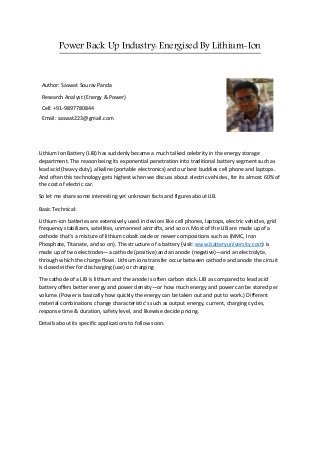
Power Back Up Industry
- 1. Power Back Up Industry: Energised By Lithium-Ion Author: Saswat Sourav Panda Research Analyst (Energy & Power) Cell: +91-9897780844 Email: saswat223@gmail.com Lithium Ion Battery (LIB) has suddenly became a much talked celebrity in the energy storage department. The reason being its exponential penetration into traditional battery segment such as lead acid (heavy duty), alkaline (portable electronics) and our best buddies cell phone and laptops. And often this technology gets highest when we discuss about electric vehicles, for its almost 60% of the cost of electric car. So let me share some interesting yet unknown facts and figures about LIB. Basic Technical: Lithium-ion batteries are extensively used in devices like cell phones, laptops, electric vehicles, grid frequency stabilizers, satellites, unmanned aircrafts, and so on. Most of the LIB are made up of a cathode that’s a mixture of lithium cobalt oxide or newer compositions such as (NMC, Iron Phosphate, Titanate, and so on). The structure of a battery (visit: www.batteryuniversity.com) is made up of two electrodes—a cathode (positive) and an anode (negative)—and an electrolyte, through which the charge flows. Lithium ions transfer occur between cathode and anode the circuit is closed either for discharging (use) or charging The cathode of a LIB is lithium and the anode is often carbon stick. LIB as compared to lead acid battery offers better energy and power density—or how much energy and power can be stored per volume. (Power is basically how quickly the energy can be taken out and put to work.) Different material combinations change characteristic’s such as output energy, current, charging cycles, response time & duration, safety level, and likewise decide pricing. Details about its specific applications to follow soon.
